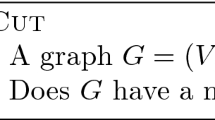Abstract
Given a graph \(G=(V, E)\), a connected cut \(\delta (U)\) is the set of edges of E linking all vertices of U to all vertices of \(V\backslash U\) such that the induced subgraphs G[U] and \(G[V\backslash U]\) are connected. Given a positive weight function w defined on E, the connected maximum cut problem (CMAX CUT) is to find a connected cut \(\varOmega \) such that \(w(\varOmega )\) is maximum among all connected cuts. CMAX CUT is NP-hard even for planar graphs, and thus for graph without the excluded minor \(K_5\). In this paper, we prove that CMAX CUT is polynomial for the class of graphs without the excluded minor \(K_5\backslash e\), denoted by \({\mathcal {G}}(K_5\backslash e)\). We deduce two quadratic time algorithms: one for the minimum cut problem in \({\mathcal {G}}(K_5\backslash e)\) without computing the maximum flow, and another one for Hamilton cycle problem in the class of graphs without the two excluded minors the prism \(P_6\) and \(K_{3, 3}\). This latter problem is NP-complete for maximal planar graphs.
Similar content being viewed by others
References
Barahona F (1990) Planar multicommodity flows, max cut, and the Chinese postman problem. In: Cook W, Seymour PD (eds) Polyhedral combinatorics, proceedings DIMACS workshop, Morristown, New Jersey, 1989, DIMACS series in discrete mathematics and theoretical computer science vol 1, pp 189–202
Barahona F, Grötschel M, Jünger M, Reinelt G (1988) An application of combinatorial optimization to statistical physics and circuit layout design. Oper Res 36:493–513
Ben-Ameur W, Mahjoub AR, Neto J (2014) The maximum cut problem. In: Paschos VT (ed) Paradigms of combinatorial optimization, problems and new approaches, 2nd edn. Wiley, Hoboken
Bodlaender HL, Jansen K (2000) On the complexity of the maximum cut problem. Nord J Comput 7(1):14–31
Bondy JA, Murty USR (2008) Graph theory with applications. Elsevier, New York
Carvajal R, Constantino M, Goycoolea M, Vielma JP, Weintraub A (2013) Imposing connectivity constraints in forest planning. Oper Res 61(4):824–836
Chaourar B (2010) A linear time algorithm for a variant of max cut in series parallel graphs. Adv Oper Res 35(1D):29–35
Garey MR, Johnson DS, Stockmeyer L (1976) Some simplified NP-complete graph problems. Theor Comput Sci 1:237–267
Grimm V, Kleinert T, Liers F, Schmidt M, Zöttl G (2019) Optimal price zones of electricity markets: a mixed-integer multilevel model and global solution approaches. Optim Methods Softw 34(2):406–436
Guruswami V (1999) Maximum cut on line and total graphs. Discrete Appl Math 92(2–3):217–221
Hadlock F (1975) Finding a maximum cut of a planar graph in polynomial time. SIAM J Comput 4:221–225
Haglin DJ, Venkatesan SM (1991) Approximation and intractability results for the maximum cut problem and its variants. IEEE Trans Comput 40(1):110–113
Hojny C, Pfetsch ME (2018) Polytopes associated with symmetry handling. Math Program Ser A. https://doi.org/10.1007/s10107-018-1239-7
Kammer F, Tholey T (2012) The complexity of minimum convex coloring. Discrete Appl Math 160:810–833
Karp RM (1972) Reducibility among combinatorial problems. In: Miller RE, Thatcher JW (eds) Complexity of computer computations. Plenum Press, New York, pp 85–103
Kleinert T, Schmidt M (2018) Global optimization of multilevel electricity market models including network design and graph partitioning. Technical report. http://www.optimization-online.org/DBHTML/2018/02/6460.html. FAU Erlangen-Nürnberg
Liers F, Martin A, Pape S (2016) Binary Steiner trees: structural results and an exact solution approach. Discrete Optim 21:85–117
Nishizeki T, Asano T, Watanabe T (1983) An approximation algorithm for the Hamiltonian walk problem on maximal planar graphs. Discrete Appl Math 5(2):211–222
Orlova GI, Dorfman YG (1972) Finding the maximal cut in a graph. Eng Cybern 10(3):502–506
Poljak S, Tuza Z (1995) Maximum cuts and largest bipartite subgraphs. In: Cook W, Lovasz L, Seymour P (eds.), Special year on combinatorial optimization, DIMACS series in discrete mathematics and theoretical computer science, vol 20, pp 181–244
Shih W-K, Wu S, Kuo YS (1990) Unifying maximum cut and minimum cut of a planar graph. IEEE Trans Comput 39(5):694–697
Terebenkov AP (1991) NP-completeness of maximum-cut and cycle-covering problems for a planar graph. Cybern Syst Analy 27(1):16–20
Vicente S, Kolmogorov V, Rother C (2008) Graph cut based image segmentation with connectivity priors. In: Computer vision and pattern recognition CVPR 2008 (IEEE conference on CVPR), pp 1–8
Wagner K (1960) Bemerkungen zu Hadwigers Vermutung. Math Ann 141:433–451
Acknowledgements
The author is grateful to anonymous referees in a previous version of this paper.
Author information
Authors and Affiliations
Corresponding author
Ethics declarations
Conflict of interest
The author declare that his has no conflict of interest.
Additional information
Publisher's Note
Springer Nature remains neutral with regard to jurisdictional claims in published maps and institutional affiliations.
Rights and permissions
About this article
Cite this article
Chaourar, B. Connected max cut is polynomial for graphs without the excluded minor \(K_5\backslash e\). J Comb Optim 40, 869–875 (2020). https://doi.org/10.1007/s10878-020-00637-6
Published:
Issue Date:
DOI: https://doi.org/10.1007/s10878-020-00637-6
Keywords
- Max cut
- Connected max cut
- Polynomial algorithm
- Min cut
- Graphs without the excluded minor \(K_5\backslash e\)
- Hamilton cycle problem




